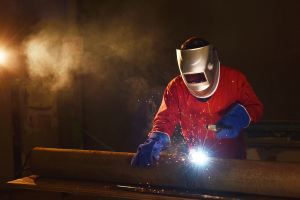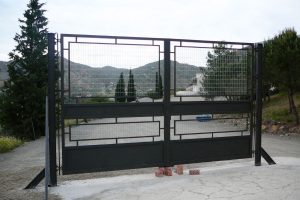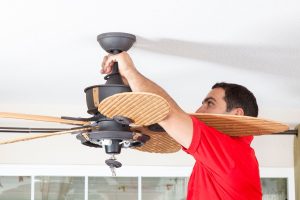Table of Contents
Ceiling fans are the greenest and most affordable way to cool your home. Ceiling fans can be installed onto all types of ceilings whether they are exposed timber beams or standard gyprock ceilings. A professional electrician will advise you on the best possible solution.
How Much is the Cost to Install Ceiling Fans?
The average cost to install a ceiling fan includes the price you pay for the ceiling fan unit plus labour cost of hiring a qualified professional electrician to install your fan. To give you an idea, you can expect to pay about $169 for a regular brushed chrome ceiling fan with a light fixture plus about $200 for labour. In total, the average cost should be around $369 or more for an entry-level ceiling fan installation.
A higher-end ceiling fan – a brushed aluminium fan with ash blades, for example, is about $769 for the unit alone. In this case, the total ceiling fan installation cost will be in the $900 to $1000 range – or more, if additional wiring is necessary.
Different Types of Ceiling Fan Prices
There are several types of ceiling fans with different features, and strength levels, and are used for different purposes. Here we’ll discuss their differences and the costs for each type:
Standard Ceiling Fans Cost
Standard ceiling fans are the ones you most commonly find in Australian homes – some with brushed nickel designs, some antique bronze, and some with a more modern aesthetic in pure black. They have 4-5 blades and usually have a light fixture installed. The average cost for standard ceiling fan installation ranges from $100 to $300.
Low Profile Ceiling Fans Cost
Low profile ceiling fans are installed in smaller rooms with a low ceiling height – usually less than 8 feet tall. Prices for this type of fan fall from $200 to $500.
Dual Motor Ceiling Fans
As the name suggests, dual motor ceiling fans have two motors and two sets of blades that rotate together when powered on. This results in stronger air circulation and is used in bigger rooms. The average cost for a dual motor ceiling fan ranges from $400 to $1000.
Damp or Wet Ceiling Fans Cost
Damp or wet ceiling fans are perfect for outdoor areas that experience more rain or humidity. They run on motors that are weather- and moisture-resistant, and they feature blades that are resistant to warping during wet weather conditions. The price range for these types of fans is $300 to $800.
Industrial or Commercial Ceiling Fans Cost
Industrial ceiling fans are meant to be used in very large areas with high ceilings such as warehouses and factories. Compared to home ceiling fans, industrial ceiling fans are more durable, have a stronger motor, and are regulated by a control box. The price for an industrial ceiling fan starts at $4,000 and can go higher depending on the size.
What Determines The Cost of Installing a Ceiling Fan
There are several factors to consider when computing the total cost of a ceiling fan installation:
- Type of fan (brand, size and additional features) – bigger fans or fans with extra features such as a light fixture, remote control, or wall switches have higher costs.
- Labour cost – the labour fee per hour usually depends on your electrician’s experience or qualifications. The more experienced electricians usually charge a premium for their expertise.
- Time and amount of labour required – more complex installations require more time and effort to accomplish, hence, costing more.
- New installation vs replacement – a replacement is expected to cost less because there are existing wires already in place.
- Additional installation costs – fans with added features like a light fixture or wall switches will also incur additional labour costs.
How To Hire a Ceiling Fan Installer
Hiring a ceiling fan installer is easy through HIREtrades. First, post the details of your project on the HIREtrades app or at hiretrades.com.au. It’s best to be as accurate as possible and to include the measurements of the area where you’d like your ceiling fan to be installed – especially your ceiling height.
It will also help to mention the brand of ceiling fan you wish to install – but you could also ask for recommendations from your electrician. Once you’ve posted on HIREtrades, our system alerts the professional ceiling fan installers in your area.
From there you’ll receive up to 3 FREE quotes to help you in your decision-making – feel free to contact as many as you can so you can feel more confident in whoever you’ll end up hiring.
How Much Does a Ceiling Fan Installer Cost?
Installation costs vary per location – you may refer to the table below to estimate installation costs per city in Australia:
| City | Average Ceiling Fan Installation Cost |
| Sydney | $150 – $450 |
| Melbourne | $150 – $250 |
| Brisbane | $150 – $550 |
| Canberra | $190 – $250 |
| Perth | $100 – $600 |
| Adelaide | $150 – $250 |
FAQs
Who can install a ceiling fan?
A ceiling fan installation requires complicated electrical work that a non-electrician is not qualified to do. Always remember that only a professional, qualified and licenced electrician is allowed to install a ceiling fan. This is to ensure a safe and working ceiling fan installation that won’t pose any risk of danger to you or anyone who lives in your home. When hiring an electrician, make sure they have the proper documentation such as licences and insurance to accomplish your ceiling fan installation. It is always much better to pay a higher labour price for a qualified electrician than to risk danger and damage to your property.
How much does it cost to run a ceiling fan?
Perhaps the most advantageous benefit of running a ceiling fan is its low energy costs, especially when compared to an air conditioning unit. A ceiling fan only consumes approximately 65 watts per hour – which is significantly lower than a 2,200 watt per hour energy consumption of an air conditioner. Installing a ceiling fan will help you save thousands of dollars in energy bills every year.
Related Handyman Resources

Cost Of Welding Per Hour
Joining two pieces of metal, such as stainless steel, copper, or any other type of metal, together isn’t a simple process. It requires experience and skill; both come at a hefty premium. So, if you have a welding job on your plate, it’s best to call in a professional.

How Much Does Gate Installation Cost?
Table of Contents The average gate installation cost in Australia is about $1,500 to $3,000

How Much Does Ceiling Fans Cost?
Table of Contents Ceiling fans are the greenest and most affordable way to cool your

